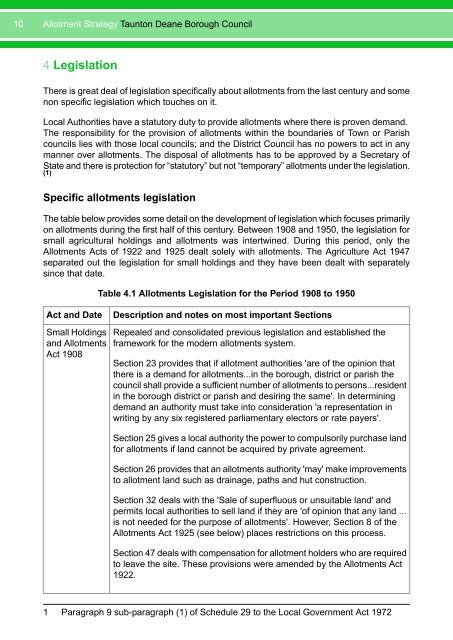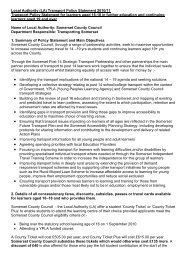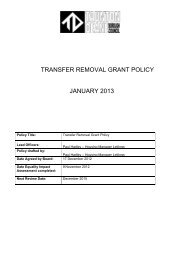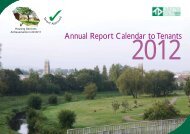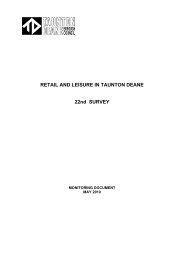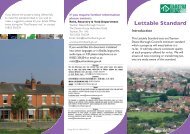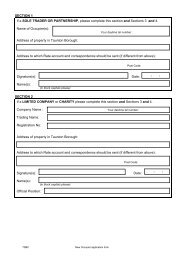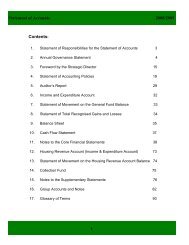Allotment Strategy (TDBC) - Taunton Deane Borough Council
Allotment Strategy (TDBC) - Taunton Deane Borough Council
Allotment Strategy (TDBC) - Taunton Deane Borough Council
You also want an ePaper? Increase the reach of your titles
YUMPU automatically turns print PDFs into web optimized ePapers that Google loves.
10<br />
<strong>Allotment</strong> <strong>Strategy</strong> <strong>Taunton</strong> <strong>Deane</strong> <strong>Borough</strong> <strong>Council</strong><br />
4 Legislation<br />
There is great deal of legislation specifically about allotments from the last century and some<br />
non specific legislation which touches on it.<br />
Local Authorities have a statutory duty to provide allotments where there is proven demand.<br />
The responsibility for the provision of allotments within the boundaries of Town or Parish<br />
councils lies with those local councils; and the District <strong>Council</strong> has no powers to act in any<br />
manner over allotments. The disposal of allotments has to be approved by a Secretary of<br />
State and there is protection for “statutory” but not “temporary” allotments under the legislation.<br />
(1)<br />
Specific allotments legislation<br />
The table below provides some detail on the development of legislation which focuses primarily<br />
on allotments during the first half of this century. Between 1908 and 1950, the legislation for<br />
small agricultural holdings and allotments was intertwined. During this period, only the<br />
<strong>Allotment</strong>s Acts of 1922 and 1925 dealt solely with allotments. The Agriculture Act 1947<br />
separated out the legislation for small holdings and they have been dealt with separately<br />
since that date.<br />
Table 4.1 <strong>Allotment</strong>s Legislation for the Period 1908 to 1950<br />
Act and Date<br />
Small Holdings<br />
and <strong>Allotment</strong>s<br />
Act 1908<br />
Description and notes on most important Sections<br />
Repealed and consolidated previous legislation and established the<br />
framework for the modern allotments system.<br />
Section 23 provides that if allotment authorities 'are of the opinion that<br />
there is a demand for allotments...in the borough, district or parish the<br />
council shall provide a sufficient number of allotments to persons...resident<br />
in the borough district or parish and desiring the same'. In determining<br />
demand an authority must take into consideration 'a representation in<br />
writing by any six registered parliamentary electors or rate payers'.<br />
Section 25 gives a local authority the power to compulsorily purchase land<br />
for allotments if land cannot be acquired by private agreement.<br />
Section 26 provides that an allotments authority 'may' make improvements<br />
to allotment land such as drainage, paths and hut construction.<br />
Section 32 deals with the 'Sale of superfluous or unsuitable land' and<br />
permits local authorities to sell land if they are 'of opinion that any land ...<br />
is not needed for the purpose of allotments'. However, Section 8 of the<br />
<strong>Allotment</strong>s Act 1925 (see below) places restrictions on this process.<br />
Section 47 deals with compensation for allotment holders who are required<br />
to leave the site. These provisions were amended by the <strong>Allotment</strong>s Act<br />
1922.<br />
1 Paragraph 9 sub-paragraph (1) of Schedule 29 to the Local Government Act 1972


